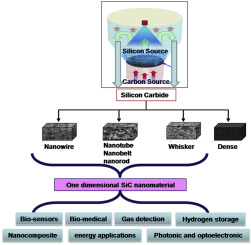当前位置:
X-MOL 学术
›
Prog. Solid State Chem.
›
论文详情
Our official English website, www.x-mol.net, welcomes your feedback! (Note: you will need to create a separate account there.)
Chemistry of one dimensional silicon carbide materials: Principle, production, application and future prospects
Progress in Solid State Chemistry ( IF 12.0 ) Pub Date : 2015-09-01 , DOI: 10.1016/j.progsolidstchem.2015.06.001 Jyoti Prakash , Ramani Venugopalan , B.M. Tripathi , S.K. Ghosh , J.K. Chakravartty , A.K. Tyagi
Progress in Solid State Chemistry ( IF 12.0 ) Pub Date : 2015-09-01 , DOI: 10.1016/j.progsolidstchem.2015.06.001 Jyoti Prakash , Ramani Venugopalan , B.M. Tripathi , S.K. Ghosh , J.K. Chakravartty , A.K. Tyagi

|
Abstract One-dimensional silicon carbide (1D SiC) nanomaterials have shown unusual properties such as extreme high strength, good flexibility, fracture toughness and inverse Hall-petch effect leading to the wide range of applications. However, the fabrication of desired 1D SiC nanomaterials with tailored atomic structures and their assembly into functional devices are still major challenges. In the present review, the recent research and trends towards the formation of SiC nanowires via different routes, their characterization and growth mechanism are discussed. Various aspects of synthesis methods for the bulk production of one dimensional SiC nanomaterials have been discussed with respect to quantity and quality. It is observed that SiC 1D nanostructures grown by different strategies exhibit unusual growth phenomena and properties. The promising myriad applications of 1D SiC nanostructures are highlighted, particularly with reference to surface dependent electronic transduction (gas and biological sensors, potentially useful in biology and medicine as well, for example, in bio-labeling), energy conversion devices (nanomechanical and photovoltaic), microelectronic, nanowire photonics and nanocomposites devices. The important aspects of SiC nanomaterials including various fabrication strategies, knowledge of microstructural evolution, applications and toxicity issues are also covered in the present review. It summarizes and projects the future prospects of 1D SiC nanostructures.
中文翻译:

一维碳化硅材料化学:原理、生产、应用及未来展望
摘要 一维碳化硅(1D SiC)纳米材料具有极高的强度、良好的柔韧性、断裂韧性和逆霍尔-佩奇效应等不同寻常的特性,得到了广泛的应用。然而,制造具有定制原子结构的所需一维 SiC 纳米材料并将其组装到功能器件中仍然是主要挑战。在本综述中,讨论了通过不同途径形成 SiC 纳米线的最新研究和趋势、它们的表征和生长机制。已经在数量和质量方面讨论了用于批量生产一维 SiC 纳米材料的合成方法的各个方面。据观察,通过不同策略生长的 SiC 1D 纳米结构表现出不寻常的生长现象和特性。强调了 1D SiC 纳米结构的有前途的无数应用,特别是在参考表面依赖性电子转导(气体和生物传感器,在生物学和医学中也有潜在用途,例如生物标记)、能量转换装置(纳米机械和光伏) )、微电子、纳米线光子学和纳米复合器件。本综述还涵盖了 SiC 纳米材料的重要方面,包括各种制造策略、微观结构演变的知识、应用和毒性问题。它总结并预测了一维碳化硅纳米结构的未来前景。在生物学和医学中也可能有用,例如,在生物标记)、能量转换设备(纳米机械和光伏)、微电子、纳米线光子学和纳米复合设备。本综述还涵盖了 SiC 纳米材料的重要方面,包括各种制造策略、微观结构演变的知识、应用和毒性问题。它总结并预测了一维碳化硅纳米结构的未来前景。在生物学和医学中也可能有用,例如,在生物标记)、能量转换设备(纳米机械和光伏)、微电子、纳米线光子学和纳米复合设备。本综述还涵盖了 SiC 纳米材料的重要方面,包括各种制造策略、微观结构演变的知识、应用和毒性问题。它总结并预测了一维碳化硅纳米结构的未来前景。
更新日期:2015-09-01
中文翻译:

一维碳化硅材料化学:原理、生产、应用及未来展望
摘要 一维碳化硅(1D SiC)纳米材料具有极高的强度、良好的柔韧性、断裂韧性和逆霍尔-佩奇效应等不同寻常的特性,得到了广泛的应用。然而,制造具有定制原子结构的所需一维 SiC 纳米材料并将其组装到功能器件中仍然是主要挑战。在本综述中,讨论了通过不同途径形成 SiC 纳米线的最新研究和趋势、它们的表征和生长机制。已经在数量和质量方面讨论了用于批量生产一维 SiC 纳米材料的合成方法的各个方面。据观察,通过不同策略生长的 SiC 1D 纳米结构表现出不寻常的生长现象和特性。强调了 1D SiC 纳米结构的有前途的无数应用,特别是在参考表面依赖性电子转导(气体和生物传感器,在生物学和医学中也有潜在用途,例如生物标记)、能量转换装置(纳米机械和光伏) )、微电子、纳米线光子学和纳米复合器件。本综述还涵盖了 SiC 纳米材料的重要方面,包括各种制造策略、微观结构演变的知识、应用和毒性问题。它总结并预测了一维碳化硅纳米结构的未来前景。在生物学和医学中也可能有用,例如,在生物标记)、能量转换设备(纳米机械和光伏)、微电子、纳米线光子学和纳米复合设备。本综述还涵盖了 SiC 纳米材料的重要方面,包括各种制造策略、微观结构演变的知识、应用和毒性问题。它总结并预测了一维碳化硅纳米结构的未来前景。在生物学和医学中也可能有用,例如,在生物标记)、能量转换设备(纳米机械和光伏)、微电子、纳米线光子学和纳米复合设备。本综述还涵盖了 SiC 纳米材料的重要方面,包括各种制造策略、微观结构演变的知识、应用和毒性问题。它总结并预测了一维碳化硅纳米结构的未来前景。


























 京公网安备 11010802027423号
京公网安备 11010802027423号